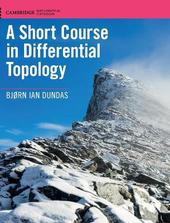
|
A Short Course in Differential Topology
Hardback
Main Details
| Title |
A Short Course in Differential Topology
|
| Authors and Contributors |
By (author) Bjorn Ian Dundas
|
| Series | Cambridge Mathematical Textbooks |
|---|
| Physical Properties |
| Format:Hardback | | Pages:262 | | Dimensions(mm): Height 260,Width 182 |
|
| ISBN/Barcode |
9781108425797
|
| Classifications | Dewey:514.72 |
|---|
| Audience | | Professional & Vocational | | Tertiary Education (US: College) | |
|---|
| Illustrations |
Worked examples or Exercises; 45 Halftones, black and white; 50 Line drawings, black and white
|
|
Publishing Details |
| Publisher |
Cambridge University Press
|
| Imprint |
Cambridge University Press
|
| Publication Date |
28 June 2018 |
| Publication Country |
United Kingdom
|
Description
Manifolds are abound in mathematics and physics, and increasingly in cybernetics and visualization where they often reflect properties of complex systems and their configurations. Differential topology gives us the tools to study these spaces and extract information about the underlying systems. This book offers a concise and modern introduction to the core topics of differential topology for advanced undergraduates and beginning graduate students. It covers the basics on smooth manifolds and their tangent spaces before moving on to regular values and transversality, smooth flows and differential equations on manifolds, and the theory of vector bundles and locally trivial fibrations. The final chapter gives examples of local-to-global properties, a short introduction to Morse theory and a proof of Ehresmann's fibration theorem. The treatment is hands-on, including many concrete examples and exercises woven into the text, with hints provided to guide the student.
Author Biography
Bjorn Ian Dundas is Professor in the Mathematics Department at the Universitetet i Bergen, Norway. Besides his research and teaching, he is the author of three books.
Reviews'Learning some topics in mathematics is a bit like climbing a mountain - it is best done with a guide. In this short course, Dundas is just that guide - revealing the best routes, giving the reader first-hand experience through lots of well-chosen exercises, providing relevant and motivating examples, and finally, making it all fun.' John McCleary, Vassar College, New York 'For such studies, the present book is excellent. It scores on a number of counts: It does a solid job on the big topics that launch the subject i.e., manifolds, the tangent space, the cotangent space - the usual suspects, as Claude Rains would have it (also of differential geometry) ... The book starts with some marvelous and - at least to me - unexpected motivations, to wit, a discussion of how a robot's arm operating in 3-space sweeps out surprising manifolds (like the torus), a discussion of the configuration space of a pair of electrons, and a discussion of state spaces and fibre bundles ... You gotta love it. It looks like a very good book.' Michael Berg, MAA Reviews '... the author has presented a wealth of important basic material of manifold theory ... in a highly enlightening, inspiring and lucid manner. No doubt, this short introduction to the subject is even more than that, namely also a gripping guide through a fascinating area of contemporary mathematics. As such it may serve as an excellent introduction to the many more advanced textbooks in the literature on differential topology.' Werner Kleinert, zbMATH 'Summing up, the book is highly recommendable for all publics. An interested student can very well go through it quite by her/himself and learn a lot. A professor surely can discover useful aspects that may have skipped her/his attention before. But most important, Professor Dundas offers us a very enjoyable reading!' Jesus M. Ruiz, European Mathematical Society (www.euro-math-soc.eu) '... the author writes in a style that students will enjoy reading: the book is quite clear, chatty to the point of being colloquial ... and filled with helpful examples ... [It] serves beautifully as a first look at this material, and does a splendid job of preparing the reader for more sophisticated accounts of the subject.' Mark Hunacek, The Mathematical Gazette
|